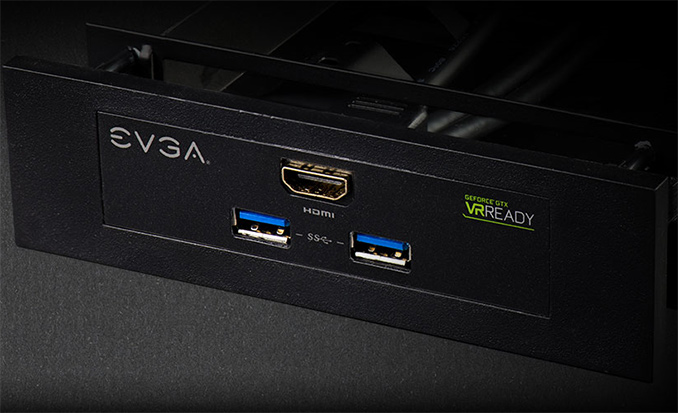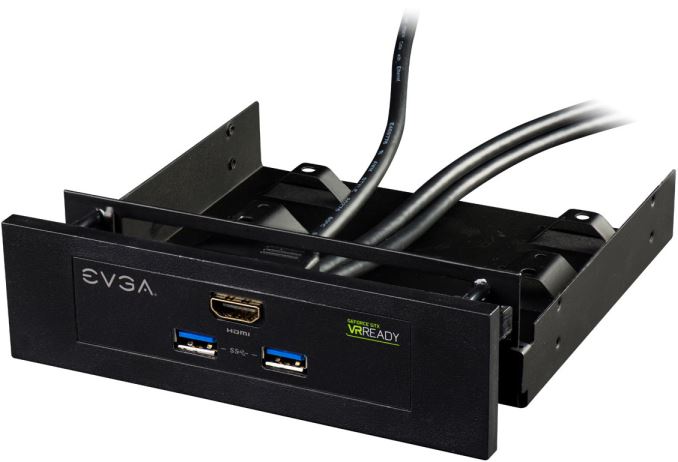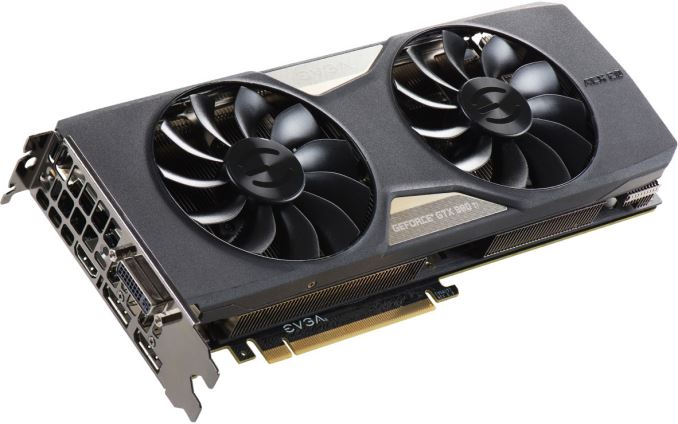EVGA Begins Selling "VR Edition" GeForce GTX Video Cards for VR Gaming Rigs
by Anton Shilov on February 11, 2016 9:00 AM EST
EVGA this week began to sell their GeForce GTX 980 Ti VR Edition video cards, a new lineup tailored for those who plan to use a virtual reality headset. The graphics boards are equipped with an internal HDMI port and a special adapter for 5.25-inch bay that simplifies plugging VR headsets to PCs.
The family of EVGA’s VR Edition graphics cards currently includes two models, both of which are modifications of EVGA's existing GTX 980 Ti card designs. The first VR Edition card is the EVGA GeForce GTX 980 Ti VR Edition Gaming ACX 2.0+ (06G-P4-3996), which uses the company’s own ACX 2.0+ cooler featuring 8-mm copper heatpipes, aluminum radiators, two fans and a memory/MOSFET cooling plate, while the second is the EVGA GeForce GTX 980 Ti VR Edition Gaming (06G-P4-3998), which uses NVIDIA’s reference cooler for high-end boards. As these are GTX 980 Ti cards, both cards are based on the GM200 GPU with 2816 stream processors, 176 texture units, 96 ROPs as well as a 384-bit memory bus. The GPUs are clocked at 1000 MHz/1076 MHz (base/boost), whereas the attaced 6 GB of GDDR5 memory is clocked at 7 Gbps.
A brief examination of the pictures provided on EVGA's website indicates that both VR Edition graphics cards are using PCBs that resemble NVIDIA’s reference designs for the GeForce GTX 980 Ti/Titan X (8pin + 6pin power inputs), but they feature an important addition. The adapters have an internal HDMI 2.0 port that connects to a special adapter for 5.25-inch bay that has an HDMI output as well as two USB 3.0 connectors. The adapter is designed to connect the Oculus Rift, the HTC Vive or any other VR headset to a PC without using ports on the backside of the computer, which makes the process considerably more comfortable.
EVGA's product literature indicates that they're primarily focused on first-time buyers - those who will be building or upgrading systems ahead of the spring VR headset launches - as these headsets will be launching some time before any 16nm high-end GPUs. That said, I wouldn't be surprised if the VR Edition cards also proved popular with gamers who already have a PC powered by the GeForce GTX 980 Ti and are looking forward to build a multi-GPU system to play VR games, as VR SLI scaling is looking optimisitc thanks to the ability to forgo AFR and assign a GPU to each eye.
From a design perspective, routing HDMI port to the backside of the card should be relatively easy. EVGA hasn't released any board shots, but they likely only had to slightly modify voltage regulating module of their GeForce GTX 980 Ti boards without any significant changes to its design. Consequently I wouldn't be surrprised if other makers of video cards do something similar later on - the idea seems rather obvious in hindsight - though for the moment EVGA is the first and only game in town. Perhaps, if VR gaming takes off in the next year or two, AMD and NVIDIA could add internal graphics ports to their reference designs.
Both EVGA GeForce GTX 980 Ti VR Edition graphics cards are available now for $699, which comes at around a $70 premium over their normal reference-clocked GeForce GTX 980 Ti boards (usually $620 - $630). As it appears, VR gamers will have to pay a extra for the VR adapter for 5.25” bays. However, given the additional comfort, it may well worth the investment, especially for those who plan on frequently plugging and unplugging VR headsets (or for that matter even tradtional HDMI displays).
Source: EVGA



















11 Comments
View All Comments
HollyDOL - Thursday, February 11, 2016 - link
How is the endurance of HDMI 2.0 connectors? Haven't had any in my hand, but I would be a bit worried plugging and unplugging stuff frequently with HDMI 1.4 ... it seems to lack the robustness of USB type-A...Murloc - Thursday, February 11, 2016 - link
I plug and unplug the same HDMI connector every working day twice a day (it's a poor's man dock station), and did so for 5 years.It feels sturdy really, I don't think this is a worry.
HollyDOL - Thursday, February 11, 2016 - link
Good to hear, thx for infoSamus - Friday, February 12, 2016 - link
I severely bent a connector on the back of my TV turning it with a cable wrapped to tight, and the connection still works fine as long as you wedge the cable so the connector doesn't fall out of the socket....all the pins still line up. Overall pretty durable. Nothing snapped.close - Friday, February 12, 2016 - link
I usually use extenders or adapters for this kind of stuff. So I buy a short extender or a swivel adapter for example and they always stay plugged in so the plug in the extender is the one taking all the wear and tear.HollyDOL - Friday, February 12, 2016 - link
That's not a bad idea... especially when the VR set will present just a short cable so there shouldn't be issues with signal quality degradation unless the extender is some lousy one.CaedenV - Thursday, February 11, 2016 - link
It runs the gamut. Some HDMI things are super flimsy and will bend/warp at the drop of a hat, while others are quite sturdy. The cables themselves tend to be fine, it is the plugs that have occasional issues.makerofthegames - Thursday, February 11, 2016 - link
I wonder if the reference-cooler one is compatible with normal liquid cooling blocks. I was planning on a beefy VR rig sometime this year, having a front-accessible HDMI port for it would be awesome.BrokenCrayons - Friday, February 12, 2016 - link
The problem with VR right now is the fact that expensive underlying hardware is necessary to properly drive it. The idea of needing at least one top end GPU plus the headset itself imposes a substantial cost barrier. Adding a second GPU for optimal experience introduces additional cost concerns AND technical problems too given the possible problems DX12 introduces with implementation of multi-GPU by pushing responsibility for functionality to cost-sensitive application developers. Much lower resolution VR screens are necessary to push hardware requirements downward so adoption by more people can provide a profit incentive for developers to soak the added cost of building in support. Smaller lithography FINALLY moving GPUs off 28nm will probably help some by making smooth VR possible with more reasonable power, space, and price requirements. I still hesitate to say that these will be anything other than poorly supported halo products that enjoy a brief period of sales before dropping off the tech interest radar just as they did before.HollyDOL - Friday, February 12, 2016 - link
Given the panel proximity to your eyes, you cannot go lower with resolution enough to make the entry for VR significantly more accessible... maybe one tier, but that's probably on the edge...